Analysing Information And Data For Problem Solving Sample Assignment
Task 1
The recent study of Germany stationary industry has revealed that the industry is doing quite well in recent years. The overall turnover of the industry is more than € 14.8 billion per year; € 35.2 billion of it is spent on writing and drawing materials (BurgerFuel, 2017).Among European Union countries, Germany ranks second in terms of spending on writing and drawing materials. Almost 70% of German stationary companies are witnessing increased sales since 2015. Germany stationary brands have good reputation in Europe and across the world. Especially writing materials produced in Germany has a significant market share against private brands (BurgerFuel, 2017). Apart from development this industry is facing challenges due to massive digitalisation and reduction in paper and paper related materials production. However, office stationary and writing instrument brands are witnessing positive growth rates. According to Trade Association for Office Supply or HBS this trend will continue in long run. Not only for official purposes, demand for stationary products has witnessed a significant growth in domestic sector as well. Findings have shown that the sale of drawing materials and painting have grown above the average rate in recent years (BurgerFuel, 2017). People are encouraging their creativity and this contributes to a great deal in this industry growth. As per statistics, more than 2000 wholesale companies are operating in Germany’s stationary industry; this includes wholesalers who are selling office supplies, paper, writing instruments as well as B2B intermediaries who directly deal with commercial customers (Apospori et al. 2012, p.30). The strategy of wholesalers of selling products directly to customers without retailer is gaining popularity in recent years, though apart from wholesalers, German stationary market is comprised of 5500 retailers who specialise in selling stationary products to customers (Kim et al. 2012, p.300).
Task 2
|
Total CD's |
% of total |
Price of CD |
Estimated Profits |
% of total profit | |
|
Complimentary |
130 |
2.7% |
0 |
-260 |
-0.75% |
|
General |
353 |
7.4% |
10 |
2824 |
8.12% |
|
Mail order |
167 |
3.5% |
10 |
1336 |
3.84% |
|
Web order |
223 |
4.7% |
10 |
1784 |
5.13% |
|
Concert Performance |
1376 |
28.8% |
12 |
13760 |
39.57% |
|
Retail |
2459 |
51.4% |
8 |
14754 |
42.43% |
|
Brighton pubs |
72 |
1.5% |
10 |
576 |
1.66% |
|
4780 |
34774 |
Task 3
a)
|
Product item |
2014 Sales (€) |
2015 Sales (€) |
2016 Sales (€) |
|
Printer cartridges |
€ 25,000.00 |
€ 26,000.00 |
€ 22,000.00 |
|
General office supplies |
€ 25,000.00 |
€ 27,000.00 |
€ 23,000.00 |
|
Low-cost printers |
€ 15,000.00 |
€ 18,000.00 |
€ 18,000.00 |
|
Office furniture |
€ 25,000.00 |
€ 25,000.00 |
€ 27,000.00 |
|
Shredders |
€ 25,000.00 |
€ 29,000.00 |
€ 29,000.00 |
|
Paper-based supplies |
€ 25,000.00 |
€ 27,000.00 |
€ 27,000.00 |
|
Writing/drawing materials |
€ 25,000.00 |
€ 30,000.00 |
€ 32,000.00 |
|
Total Sales |
€ 165,000.00 |
€ 182,000.00 |
€ 178,000.00 |
b)
Printer Cartridge
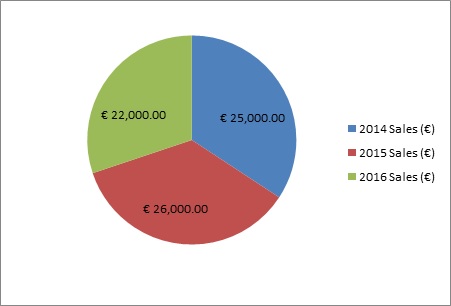
General office supplies
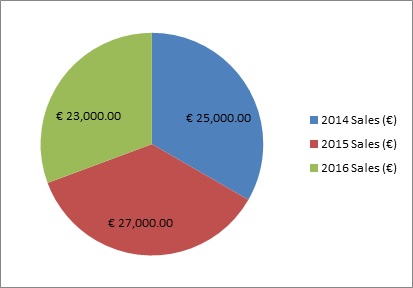
Low cost printers
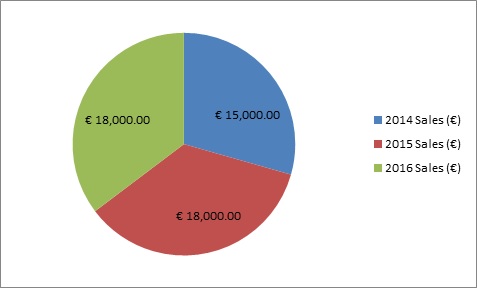
Office Furniture
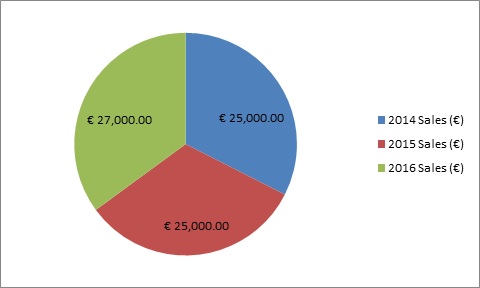
Shredders
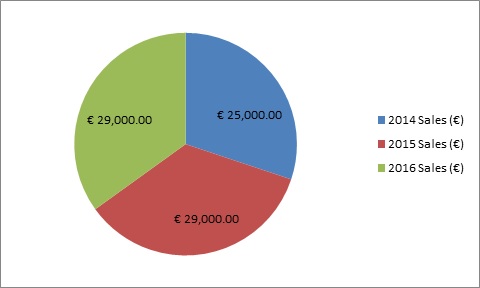
Paper Based supplies
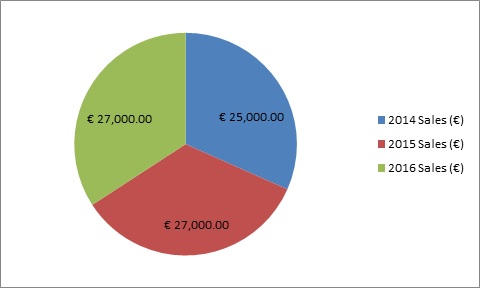
Writing/Drawing materials
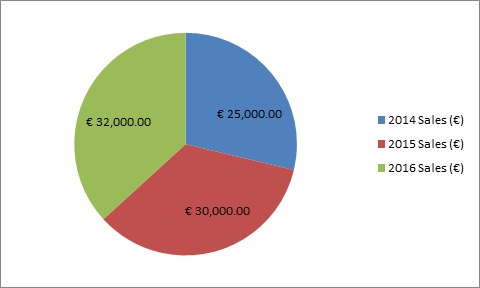
c)
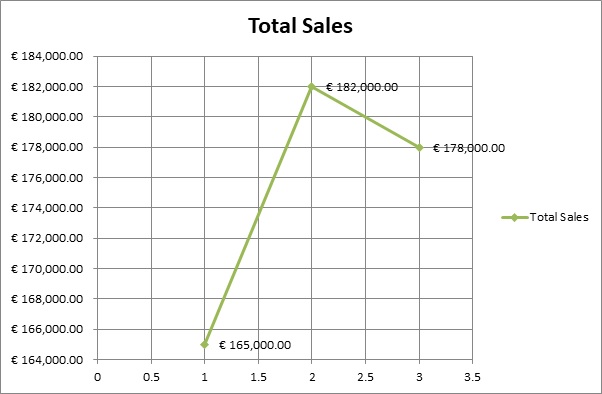
Correlation and coefficient:
|
YEAR |
Correlation and coefficient |
|
2014-2015 |
0.900885233 |
|
2014-2016 |
0.693888666 |
|
2015-2016 |
0.847510399 |
It is evident from the correlation and coefficient that 2014-2015 has a strong uphill (positive) linear relationship. It is almost a perfect linear relationship (0.900885233) between 2014-2015. Moreover, in 2015-2016 a strong linear relationship is witnessed.
d)
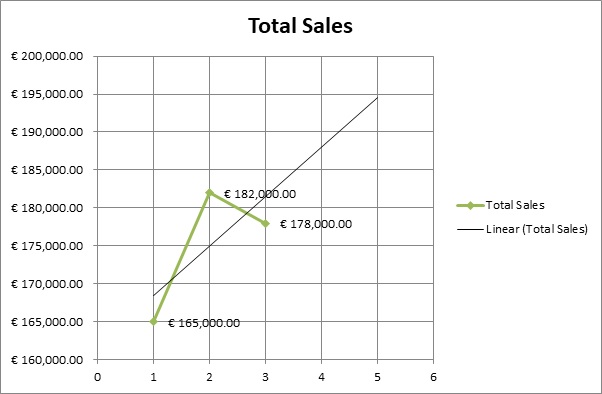
This continuous sales trend has witnessed that in 2016 company sales has gone down from previous year sales, though in 2017 Duque Papetiers Gros will witness €190000.00 sales and in 2018 the sales figure will be increased to €195000.00
Task 4
Should I expand my business to online (B2B)?
|
Pros |
Score/10 |
Cons |
Score/10 |
|
Payment speed, no issue of delayed payments or cheque bounce |
7 |
Lacks personal communication |
5 |
|
Receive orders from clients round the clock |
8 |
Online payment could be inflated and this affects the revenue |
6 |
|
Could reach clients from distant cities, states and countries |
7 |
Flexibility is missing, loyal customer can’t get benefits of special offers and discounts |
5 |
|
Online communication with clients incurs low cost |
7 | ||
|
Total Pros |
29 |
Total Cons |
16 |
|
Average Pros |
7.25 |
Average Cons |
5.33 |
Figure T4: A ‘pros and cons method’ table for expanding to B2B
Task 5
a)
“Should I expand my business to Belgium and Germany?”
|
Pros |
Score/10 |
Cons |
Score/10 |
|
Germany has the largest economy and largest population in Europe |
8 |
German government regulations are protective and complex, especially in maintaining environmental standard |
6 |
|
Small and medium sized business are the main source of German economy |
8 | ||
|
Belgium has highly sophisticated infrastructure, railways and state of the art telecommunications network |
7 |
High marginal tax rate and complex tax laws could be an obstacle for business in Belgium |
7 |
|
Total Pros |
23 |
Total Cons |
13 |
|
Average Pros |
7.66 |
Average Cons |
6.5 |
b) International Organization for Standardization is an international standard setting body comprised of representatives of various national standards organizations (Anderson et al. 2011). Headquartered in Geneva, Switzerland this organization promotes industrial, commercial and proprietary standards (Torugsa et al. 2012, p.499). For Duque Papetiers Gros there are mainly three standards that should be followed, these three standards are ISO 9000 Quality Management, ISO 14000 family-Environmental management and ISO 26000 Social Responsibility.
ISO 9000 Quality Management: This standard provides guidance and tools for companies and organizations to help the companies to meet customer’s requirements (Mitchell, 2013). This standard focuses on customer standard, implication and motivation of top management. This standard makes sure that customers get good quality products and services that would bring benefits to the business (Kidalov, 2011, p.450). Duque Papetiers Gros is a family stationary business in Northern France and it has a loyal customer base for more than 50 years. This company has a positive image as a trustworthy, reliable company, so to maintain this image; company needs to abide by ISO 9000 Quality Management standard to meet customer’s requirement (Jones et al. 2013, p.60).
ISO 14000 family-Environmental management: This standard focuses on environmental systems. This standard focuses on communications, audits, life cycle analysis, labelling and environmental challenges such as climate change (Murillo-Luna et al. 2011, p.1420) . Duque Papetiers Gros has its product base in printer cartridge, office supplies, paper based supplies and writing and drawing materials. While using the paper the company should maintain ISO 14000 Environmental management not to violate the environmental standard set by this international organization (Müsgens et al. 2014, p.398).
ISO 26000 Social Responsibility: Any organization or business needs to operate in good relationship with society and environment to work effectively for longer terms (Babiak and Trendafilova, 2011, p.20). This is a parameter to measure their all over performance as well. This standard gives guidance of doing business in a socially responsible way that would contribute to the welfare of the society (Vázquez-Carrasco and López-Pérez, 2013, p.3206). This company has an impression of donating generously in local charities related to primary schools (Polasky et al. 2011, p.400). This way, Duque Papetiers Gros is contributing towards social responsibility and it is very essential for the company to follow the international standard of ISO 26000 to maintain its overall performance.
Task 6
The two hypothesis are as follows:
H0 : μ = €240
H1 : μ ≠ €240
Hence, standard error = s√𝑛⁄ = 43√50⁄ = 437.07⁄ = 6.08 (to 2 d.p.) = 6 (to 1 s.f.)
From the above it can be assumed that the same would lie within the significance level.
Task-7
a)
The following suggestions has to be adopted to increase the response level of the customers with respect to the questionnaire
- The questions should be short and easily understandable
- The most questions has to be answered by yes and know
- Small discounts or cash awards or shopping points should be offered to the customers for returning the properly completed questionnaire
- Priority shopping facility to be given to the customers who are returning the properly completed questionnaire
b)
|
Sl no. |
CUST_SERV |
QUAL_P&S |
SALES_STAFF |
PRICE_VALUE | |
|
1 |
3 |
3 |
3 |
3 | |
|
2 |
3 |
3 |
3 |
2 | |
|
3 |
4 |
4 |
4 |
2 | |
|
4 |
4 |
3 |
4 |
1 | |
|
5 |
2 |
3 |
2 |
2 | |
|
6 |
4 |
4 |
4 |
2 | |
|
7 |
4 |
3 |
4 |
2 | |
|
8 |
4 |
3 |
4 |
2 | |
|
9 |
2 |
3 |
2 |
2 | |
|
10 |
4 |
3 |
4 |
1 | |
|
11 |
4 |
3 |
4 |
2 | |
|
12 |
4 |
3 |
4 |
2 | |
|
13 |
4 |
3 |
4 |
2 | |
|
14 |
4 |
3 |
4 |
1 | |
|
15 |
2 |
3 |
2 |
2 | |
|
16 |
4 |
3 |
4 |
2 | |
|
17 |
4 |
4 |
4 |
2 | |
|
18 |
3 |
3 |
3 |
3 | |
|
19 |
4 |
3 |
4 |
2 | |
|
20 |
3 |
3 |
2 |
2 | |
|
3.5 |
3.15 |
3.45 |
1.95 |
mean | |
|
0.76088591 |
0.36634755 |
0.825577947 |
0.510417786 |
SD |
According to the descriptive statistical analysis the variable “SALES_STAFF” is the cause of incomplete return of the questionnaire.
Task-8
The most important findings with respect to this quantitative analysis as follows:
Printer cartridges and the Writing/drawing materials are one the most important sales material of the European stationary market.A stable rising trend can be observed in the sales of the products.Expansion of business is possible in Germany and France stationary market as the positive points of sales expansion are more than the negative points. Most of the customers of the stationary industry are very reluctant to return the fully completed questionnaire form
Improvement should be brought with respect to the variables “CUST_SERV” and “SALES_STAFF”. Because, these variables shows sd values that are close to 1.
Reference List:
Books
Anderson, B., Leib, J., Martin, R., McGuigan, M., Muûls, M., Wagner, U.J. and de Preux, L.B., 2011. Climate change policy and business in Europe. evidence from interviewing managers.
Mitchell, B., 2013. Resource & environmental management. Routledge.
Journals
Kidalov, M.V., 2011. Small business contracting in the United States and Europe: A comparative assessment. Public Contract Law Journal, pp.443-509.
Jones, P., Beynon, M.J., Pickernell, D. and Packham, G., 2013. Evaluating the impact of different training methods on SME business performance. Environment and Planning C: Government and Policy, 31(1), pp.56-81.
Murillo-Luna, J.L., Garcés-Ayerbe, C. and Rivera-Torres, P., 2011. Barriers to the adoption of proactive environmental strategies. Journal of Cleaner Production, 19(13), pp.1417-1425.
Müsgens, F., Ockenfels, A. and Peek, M., 2014. Economics and design of balancing power markets in Germany. International Journal of Electrical Power & Energy Systems, 55, pp.392-401.
Babiak, K. and Trendafilova, S., 2011. CSR and environmental responsibility: motives and pressures to adopt green management practices. Corporate social responsibility and environmental management, 18(1), pp.11-24.
Polasky, S., Carpenter, S.R., Folke, C. and Keeler, B., 2011. Decision-making under great uncertainty: environmental management in an era of global change. Trends in ecology & evolution, 26(8), pp.398-404.
Vázquez-Carrasco, R. and López-Pérez, M.E., 2013. Small & medium-sized enterprises and Corporate Social Responsibility: a systematic review of the literature. Quality & Quantity, 47(6), pp.3205-3218.
Torugsa, N.A., O’Donohue, W. and Hecker, R., 2012. Capabilities, proactive CSR and financial performance in SMEs: Empirical evidence from an Australian manufacturing industry sector. Journal of Business Ethics, 109(4), pp.483-500.
Apospori, E., Zografos, K.G. and Magrizos, S., 2012. SME corporate social responsibility and competitiveness: a literature review. International Journal of Technology Management, 58(1/2), pp.10-31.
Kim, D.Y., Kumar, V. and Kumar, U., 2012. Relationship between quality management practices and innovation. Journal of Operations Management, 30(4), pp.295-315.
Sıtkı İlkay, M. and Aslan, E., 2012. The effect of the ISO 9001 quality management system on the performance of SMEs. International Journal of Quality & Reliability Management, 29(7), pp.753-778.
Zelnik, M., Maletič, M., Maletič, D. and Gomišček, B., 2012. Quality management systems as a link between management and employees. Total Quality Management & Business Excellence, 23(1), pp.45-62.
Kober, R., Subraamanniam, T. and Watson, J., 2012. The impact of total quality management adoption on small and medium enterprises’ financial performance. Accounting & Finance, 52(2), pp.421-438.
Kim, D.Y., Kumar, V. and Kumar, U., 2012. Relationship between quality management practices and innovation. Journal of Operations Management, 30(4), pp.295-315.
Website:
Malaysia, A. (2017). MGCC Perspectives. Malaysia.ahk.de. Retrieved 14 April 2017, from


